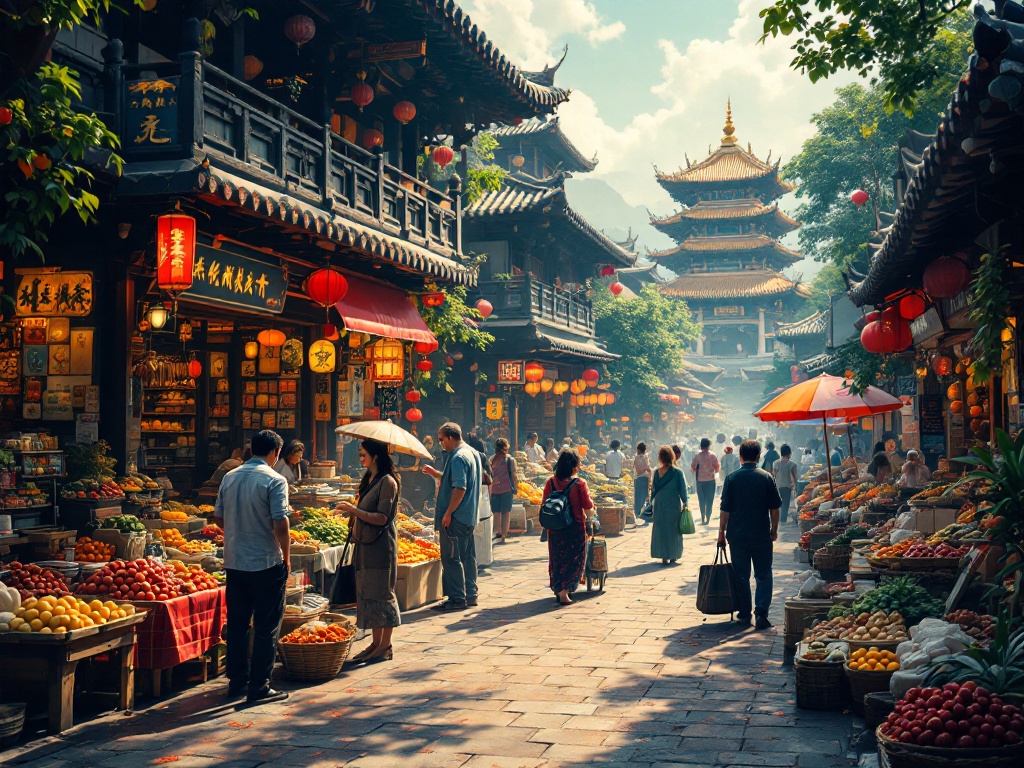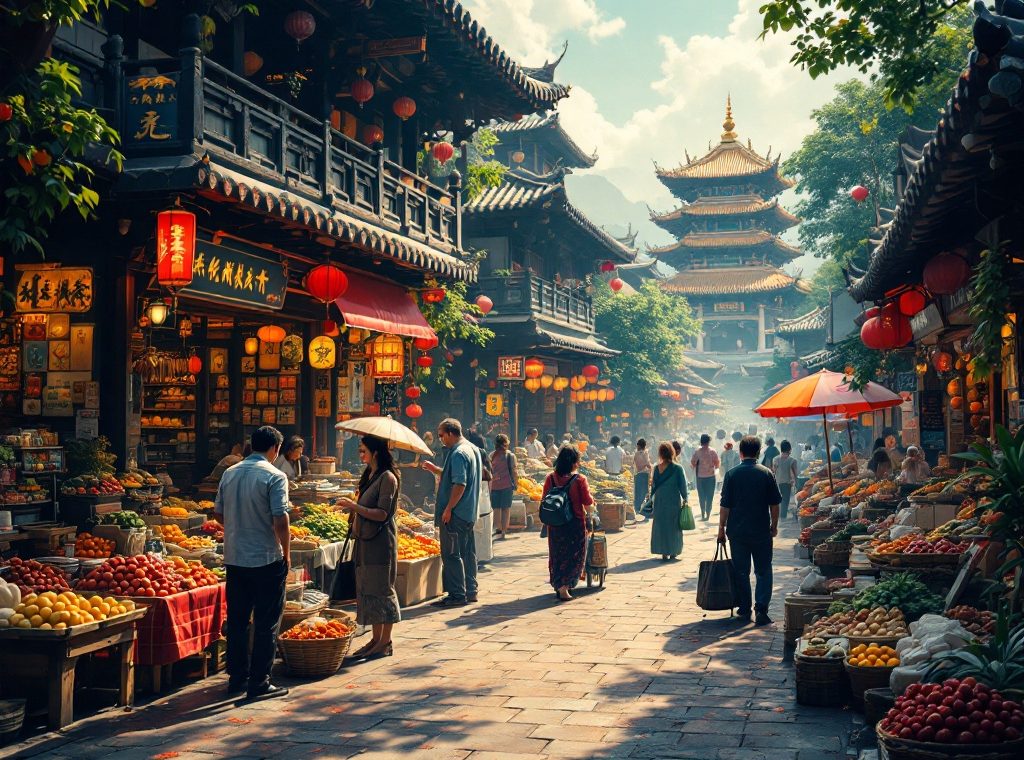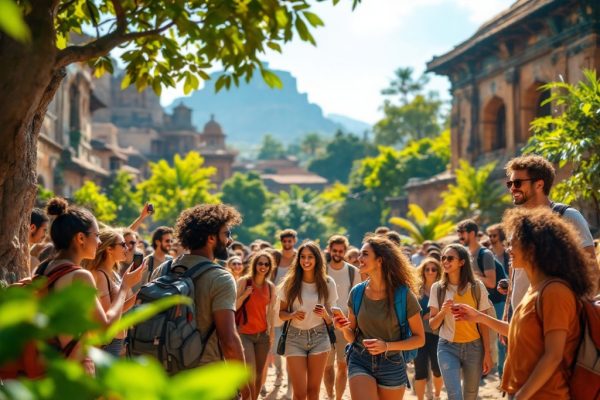Essential Tips for First-Time Travelers to Asia
Dreaming of exploring Asia? From bustling markets to serene temples, your first Asian adventure awaits! This comprehensive guide provides essential tips for a smooth and enriching journey. Learn about visa requirements, cultural etiquette, packing essentials, health precautions, and smart budgeting. Discover how to navigate transportation, stay safe, and truly immerse yourself in the local culture. Start planning your unforgettable Asian experience today!
Important information

- Research visa requirements, local customs, and currency exchange before you go.
- Get travel insurance for emergencies, cancellations, and medical expenses.
- Pack light, versatile clothing, comfortable shoes, and a universal adapter.
- Respect local customs by dressing modestly, learning basic phrases, and being mindful of traditions.
- Consume safe food and water. Choose busy street food stalls and reputable restaurants. Carry a reusable water bottle and purification method if needed.
Preparing for Your First Trip to Asia
Planning your first Asian adventure? Here’s how to ensure a smooth and enriching experience:
Research is key. Begin by thoroughly researching visa requirements, currency exchange rates, local customs, and essential destinations. This preparation will alleviate pre-trip anxieties and enhance your travel experience.
Learn basic phrases. Demonstrating respect for the local culture by learning basic phrases will significantly improve communication and foster positive interactions.
Secure travel insurance. Travel insurance is crucial for unforeseen circumstances. It provides financial protection and peace of mind during your trip.
Photocopy important documents. Make photocopies of your passport, visa, and other essential documents. Store them separately from the originals in case of loss or theft.
Pack smart. Choose versatile clothing suitable for various climates and activities. This will minimize luggage and maximize your comfort.
Bring a universal adapter. A universal power adapter is essential for charging your electronic devices, ensuring you stay connected throughout your journey.
Don’t forget medications. Remember to pack any essential medications you require, ensuring you have an adequate supply for the duration of your trip.
Embrace the unexpected. Be prepared for unexpected events. Flexibility is key when travel plans change, allowing you to adapt and enjoy the journey regardless of unforeseen circumstances. Respecting local traditions will enhance your cultural immersion and create a more meaningful experience.
Passports and Visas: What You Need to Know
For international travel, your passport must be valid for six months beyond your return date.
Depending on your nationality and destination, a visa may be required.
Confirm the specific visa requirements by checking the embassy or consulate website for the country you’re visiting, as these can vary based on your trip’s purpose and duration.
Securing the correct visa beforehand will ensure a smooth entry into your destination country.
Vaccinations and Health Precautions
Consult your doctor or the CDC website to determine necessary vaccinations before your trip to Asia.
Pack a first-aid kit with essential medications.
Practice safe food and water habits to maintain good health during your travels.
Consider travel insurance that covers medical expenses and emergencies.
Stay hydrated, especially in hot climates.
Be mindful of potential altitude sickness in mountainous regions.
Travel Insurance Considerations
Travel insurance safeguards you from unexpected problems, like trip cancellations or medical emergencies abroad. It also covers lost luggage and flight disruptions, offering financial and support services during crucial times. This makes your trip safer and less stressful, giving you peace of mind. Insure your journey and travel worry-free.
Travel Planning and Preparation
Planning your Asian Adventure
Before You Go
- Research your destinations, including local customs and cultural nuances.
- Learn a few basic phrases to enhance interactions.
- Create a flexible itinerary, allowing room for spontaneous discoveries.
- Anticipate potential travel disruptions and have backup plans.
Essential Travel Documents
- Ensure your passport is valid for at least six months beyond your return date.
- Obtain comprehensive travel insurance.
- Check visa requirements for your destinations.
- Research recommended vaccinations and travel advisories.
Packing Smart
- Pack light, choosing versatile clothing suitable for various climates and cultural norms.
- Bring a universal power adapter.
Managing Your Finances
- Familiarize yourself with local currencies and exchange rates.
- Use travel-friendly credit cards or cash to minimize transaction fees.
- Research the cost of living and establish a daily budget.
- Utilize public transport and explore local markets to save money.
Book accommodations in advance, especially during peak season.
Embrace the experience with an open mind.
Savor the rich cultural diversity Asia offers.
Researching Destinations and Itineraries
Embark on a journey of discovery!
Research destinations. Delve into their unique cultures and captivating local attractions, igniting your wanderlust and setting the stage for an unforgettable experience.
Craft a flexible itinerary. Embrace spontaneity and allow room for unexpected adventures, avoiding a rigid schedule that may stifle your exploration.
Ensure your visa requirements are met. Stay informed about travel advisories and health recommendations, prioritizing your safety and well-being throughout your journey.
Budget wisely. Factor in accommodations, meals, and activities, ensuring a financially responsible and enjoyable trip.
Immerse yourself in the local culinary scene. Consider joining a food tour tailored to your tastes and dietary preferences, savoring authentic flavors and creating lasting memories.
Understanding Cultural Differences
Respect is crucial for a rewarding Asian adventure. Before embarking on your journey, research local customs and traditions. Dress modestly, particularly when visiting religious sites. Observe local greetings and dining habits. Engage respectfully with locals and ask questions to deepen your cultural understanding. Be mindful of personal space and communication styles to avoid misunderstandings. For example, removing your shoes before entering homes is customary in some cultures. Learning basic phrases demonstrates respect and facilitates communication. Embrace cultural differences with an open mind and adaptability for a richer travel experience.
Research local customs. Before you travel, research the local customs and traditions of the places you plan to visit. This will help you avoid unintentional cultural faux pas.
Dress modestly. Dress modestly, especially when visiting religious sites. This shows respect for local customs and beliefs.
Observe greetings and dining habits. Pay attention to how locals greet each other and conduct themselves during meals. Follow their lead to show respect.
Engage respectfully and ask questions. Engage respectfully with locals and ask questions to learn more about their culture. This demonstrates genuine interest and fosters positive interactions.
Be mindful of personal space. Be aware of personal space and communication styles. Different cultures have different norms regarding physical proximity and communication.
Learn basic phrases. Learning basic phrases in the local language demonstrates respect and can greatly enhance your communication with locals.
Dealing with Jet Lag and Sensory Overload
Combat jet lag by staying hydrated and progressively adapting your sleep pattern to your destination’s time zone. Minimize sensory overload by incorporating quiet time into your schedule and concentrating on one sense at a time. Prioritize rest and take breaks to maintain your energy levels.
Packing Essentials for Asia
Pack light, multi-purpose clothing for your Asian adventure.
Comfortable walking shoes are essential for exploring diverse landscapes.
Protect yourself from the sun with sunscreen, sunglasses, and a hat.
Pack a rain jacket or umbrella for unexpected showers.
Stay hydrated with a reusable water bottle.
Remember travel adapters to keep your electronics charged.
Pack necessary medications in their original containers and a small first-aid kit for minor injuries.
Insect repellent is a good idea, especially in tropical areas.
Dress modestly when visiting religious sites.
A power adapter is crucial, as plug types vary across Asia.
Keep copies of important documents, like your passport and visa, separate from the originals.
Light and Versatile Clothing
When packing, prioritize lightweight, versatile clothing items that can be easily layered. Breathable, comfortable fabrics like linen, cotton, or merino wool are ideal, especially for warm, humid destinations. Neutral colors simplify outfit coordination. A lightweight scarf or shawl can provide modesty when visiting religious sites.
Comfortable and Stout Walking Shoes
Comfortable, sturdy walking shoes are essential for exploring Asia’s diverse terrain, from bustling city streets to rugged mountain trails. In warmer climates, hiking sandals offer breathability and quick-drying comfort. Durable footwear is key, providing crucial support for long days of walking and sightseeing. For footwear that combines comfort and style, consider these options:
Walking Shoes
Prioritize comfort and support. Look for features like cushioned insoles, arch support, and breathable materials. Ensure a snug fit to prevent blisters and discomfort during long walks.
Hiking Sandals
In hot and humid climates, hiking sandals provide excellent breathability and quick-drying comfort. Choose sandals with adjustable straps for a secure fit and sturdy outsoles for good traction.
Sun Protection and Waterproof Gear
- Pack sweat-resistant, high-SPF sunscreen.
- Bring a breathable, waterproof rain jacket, especially important during monsoon season.
- Include a dry bag to protect electronics and documents from rain and humidity.
Budgeting and Money Management
Money Exchange
For the best exchange rates, try local banks or exchange bureaus. Airport kiosks tend to offer less favorable rates. ATMs are a convenient option, but be wary of Dynamic Currency Conversion (DCC). DCC displays the transaction amount in your home currency, but the exchange rate is often worse than your bank’s. Always choose to be charged in the local currency to use your bank’s rate.
Payment Methods and Tips
Credit cards are widely accepted in major Asian cities, but cash is preferred in smaller towns and markets. Inform your bank of your travel dates to prevent card blockage. Carry a backup card in case of loss or theft. ATMs are widely available, but be aware of potential fees. Minimize fees by withdrawing larger amounts less frequently. Keep small bills handy for tips, street food, and small purchases.
Currency Exchange and Local Currency
For better exchange rates, bypass airport kiosks and consider these options:
- banks,
- authorized exchange bureaus,
- your hotel.
Carrying local currency is crucial for:
- transactions with small vendors,
- enjoying street food,
- navigating local transportation.
While credit cards are often accepted in larger establishments, having local cash ensures a smoother, more convenient experience.
Using Credit Cards and ATMs
Credit cards are widely accepted in major Asian cities like Tokyo, Seoul, Singapore, and Hong Kong. ATMs are readily available in urban areas, but they can be more difficult to find in rural locations. Before your trip, check with your bank about any applicable fees, such as international transaction fees and ATM withdrawal charges. Informing your bank of your travel dates can also help avoid any security blocks on your cards. It’s also recommended to carry some local currency for smaller purchases and transportation, especially outside of large cities.
Transportation Tips for Asia
Traveling affordably in Asia opens up a world of possibilities. Here’s how to make the most of your budget:
Flights
Asian budget airlines like AirAsia, Scoot, and Jetstar offer excellent value. Booking in advance, particularly during peak season, often yields significant savings. Leverage flight comparison websites such as Skyscanner and Google Flights to uncover the best deals.
Public Transport
Public transport offers an efficient and affordable way to navigate Asia’s cities. Extensive metro and bus systems are common, and travel passes can simplify journeys while saving money, especially for frequent trips. Research city-specific options like stored-value cards or multi-day passes.
Tuk-Tuks
Tuk-tuks provide a unique travel experience in Southeast Asian countries like Thailand. Remember to negotiate the fare upfront.
High-Speed Rail
High-speed rail is widespread across Asia, providing quick and comfortable connections between major cities. Research routes and book tickets early, especially for peak travel periods.
Japan Rail Pass
For travel within Japan, the Japan Rail Pass offers unlimited access to JR trains, including the Shinkansen bullet train.
Air Flight Tickets and Budget Airlines
Looking to explore Asia affordably? Consider budget airlines such as Scoot, AirAsia, and Jetstar Asia. Their competitive fares can help you maximize your travel budget, allowing you to experience more destinations for less.
Public Transport and Travel Passes
Exploring Asia? Public transportation offers a cost-effective and immersive way to experience your journey. Utilize the extensive train networks, convenient subway systems, and comprehensive bus routes to navigate with ease. Many cities provide discounted travel passes, so research options at your destinations before embarking. Planning your routes in advance will enhance your travel experience. Embrace the adventure and discover Asia through its vibrant public transportation systems.
Tuk Tuks, Japan Rail Pass, and Speed Trains
Tuk-tuks offer a unique transportation experience in Southeast Asian countries like Thailand, Cambodia, and Laos. In contrast, Japan offers an efficient rail system best accessed with the Japan Rail Pass. This pass provides economical travel, including access to the Shinkansen bullet train. High-speed rail networks are also transforming travel throughout other parts of Asia. China, South Korea, and Taiwan have impressive systems, perfect for long distances. Exploring local travel passes can enhance the affordability and efficiency of your trip.
Safety Tips for First-Time Travelers
Research and Respect
Research local laws and customs at your destination. This will enhance both your safety and cultural sensitivity.
Protect Your Belongings
Be discreet with valuables and avoid displaying expensive jewelry or electronics, especially in crowded areas. This can significantly deter theft.
Safe Transportation
Choose reputable transportation options and avoid traveling alone at night, particularly in unfamiliar locations.
Stay Connected
A local SIM card simplifies communication. Knowing the location of your embassy and local emergency numbers is key to preparedness.
Trust Your Instincts
If a situation feels unsafe, remove yourself. Your gut feeling is often your best guide.
Avoiding Scams and Staying Alert
Be aware of common scams targeting tourists, such as selling overpriced or counterfeit goods. Beggars often use distraction techniques to steal from unsuspecting individuals. Maintain situational awareness, especially in crowded areas. Protect your belongings and avoid displaying large sums of money. If a situation feels suspicious, trust your instincts and remove yourself.
Be cautious of scams involving overpriced or counterfeit goods.
Be aware of distraction techniques used by beggars.
Maintain situational awareness, especially in crowded areas.
Protect your belongings.
Avoid displaying large sums of money.
Trust your instincts and remove yourself from suspicious situations.
Solo Travel Considerations
Planning a solo trip to Asia? Prioritize your safety with these tips: choose accommodations with positive reviews, keep emergency contacts readily available, share your itinerary, and stay aware of your surroundings.
Understanding and Respecting Local Cultures
Respecting local customs is key to a positive travel experience. Researching cultural norms before your trip can prevent unintentional offenses. Dress modestly, particularly at religious sites, often requiring covered shoulders and knees. Public displays of affection may be inappropriate. In many Asian countries, remove your shoes before entering homes or businesses.Learning basic local greetings shows respect. Be mindful of personal space. Avoid raising your voice or displaying anger. Always ask permission before taking photos. Bargaining respectfully is common in markets.When visiting temples, dress modestly with covered shoulders and knees, and sometimes your head. Remove your shoes at the entrance. Speak softly inside. Avoid disruptive behavior. Pointing your feet at religious statues or monks is often disrespectful. Observe posted signs regarding photography and follow staff instructions.
Modest Dress and Cultural Norms
When visiting, dress modestly, particularly at religious sites, to show respect for local customs. It’s also customary to remove your shoes before entering homes and certain sacred places. Proper chopstick etiquette demonstrates respect, especially at mealtimes. Observing these cultural norms will enhance your travel experience and show respect for local traditions.
Interacting with Locals: Do’s and Don’ts
Immerse yourself in the local culture by learning basic greetings. This shows respect and creates positive interactions. Researching local customs before your trip can prevent misunderstandings.
Always ask permission before taking photos of people, and be mindful of personal space. Supporting local businesses directly benefits the community.
Avoid raising your voice or showing anger publicly. Public displays of affection might be culturally inappropriate, as can discussions about sensitive topics like politics or religion.
Avoid pointing with your index finger; use your whole hand instead. Littering is disrespectful, and bargaining in markets should be done respectfully.
Visiting Temples: Etiquette and Dress Code
When visiting Asian temples, remember to remove your shoes and socks as a sign of respect. Dressing modestly is also essential, so long sleeves or shawls are often required.
Health and Hygiene Considerations
Stay healthy on your travels by following these hygiene tips. Wash your hands often, especially after using the restroom and before meals. If soap and water aren’t available, use hand sanitizer. Drink bottled or purified water to avoid waterborne illnesses. Be careful with raw or undercooked food, including street vendor fare. Choose reputable restaurants and make sure your food is thoroughly cooked and served hot.
Before You Go
- Pack a complete first-aid kit with bandages, antiseptic wipes, pain relievers, personal medications, and motion sickness remedies if needed.
- Talk to your doctor about recommended vaccinations and health precautions for your destinations.
- If you have dietary restrictions, learn how to communicate them in the local language or carry a translation card.
Upon Arrival
- Register with your embassy for assistance in emergencies.
For Your Trip to Asia
Consult your doctor about vaccinations and preventative medications.
- Pack enough prescribed medication for your entire trip, along with copies of your prescriptions.
- Bring insect repellent with DEET or picaridin to ward off mosquito-borne illnesses.
- Pack anti-diarrheal medication, oral rehydration salts, and antihistamines for common travel issues.
- Seek medical care if you have persistent or severe symptoms.
Preventing Illness and Staying Healthy
Wash your hands frequently, especially after using the restroom and before meals.
Use bottled water for drinking, brushing your teeth, and rinsing produce.
Avoid raw or undercooked foods, opting for cooked meals instead. Ensure meat and seafood are cooked thoroughly.
Peel your own fruits for added safety.
Stay hydrated by drinking plenty of bottled water, especially in warm climates.
Pack a basic first-aid kit containing antiseptic wipes, bandages, pain relievers, and any personal medications.
Consult your doctor about recommended vaccinations and medications for your destination before traveling.
Pharmaceuticals and Bug Spray
Before embarking on your journey, gather essential medications such as pain relievers, antidiarrheals, and motion sickness remedies. Pack insect repellent containing DEET to ward off mosquitoes and other biting insects. It is strongly advised to consult your doctor regarding necessary vaccinations and malaria prevention. Lastly, include a basic first-aid kit for treating minor injuries.
Food and Water Safety Tips
Enjoy the diverse world of street food and local flavors while staying safe. Choose busy stalls where high turnover usually means fresh ingredients. Observe food preparation, looking for hygienic practices. Peel fruits yourself and avoid raw or undercooked meat. In restaurants, opt for reputable establishments. Staying hydrated is essential, so carry a reusable water bottle. If tap water isn’t safe, use purification tablets or a filter. Bottled water is widely available, but always check the seal.
Street Food Safety
- Select busy stalls with high customer turnover, indicating fresh food.
- Observe food handling practices for hygiene.












